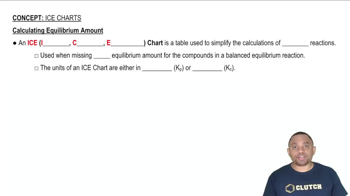Here are the essential concepts you must grasp in order to answer the question correctly.
Equilibrium Constant (Kc)
The equilibrium constant (Kc) is a numerical value that expresses the ratio of the concentrations of products to reactants at equilibrium for a given reaction at a specific temperature. It is calculated using the formula Kc = [products]^[coefficients] / [reactants]^[coefficients]. A larger Kc indicates a greater concentration of products at equilibrium, while a smaller Kc suggests that reactants are favored.
Recommended video:
Equilibrium Constant Expressions
ICE Table
An ICE table (Initial, Change, Equilibrium) is a tool used to organize the concentrations of reactants and products in a chemical reaction at different stages. It helps in determining the changes in concentration as the reaction progresses towards equilibrium. By filling in the initial concentrations, the changes that occur, and the equilibrium concentrations, one can easily calculate the equilibrium constant.
Recommended video:
ICE Charts and Equilibrium Amount
Le Chatelier's Principle
Le Chatelier's Principle states that if a dynamic equilibrium is disturbed by changing the conditions, the system will adjust itself to counteract the change and restore a new equilibrium. This principle is crucial for understanding how changes in concentration, pressure, or temperature can affect the position of equilibrium and the value of the equilibrium constant.
Recommended video:





